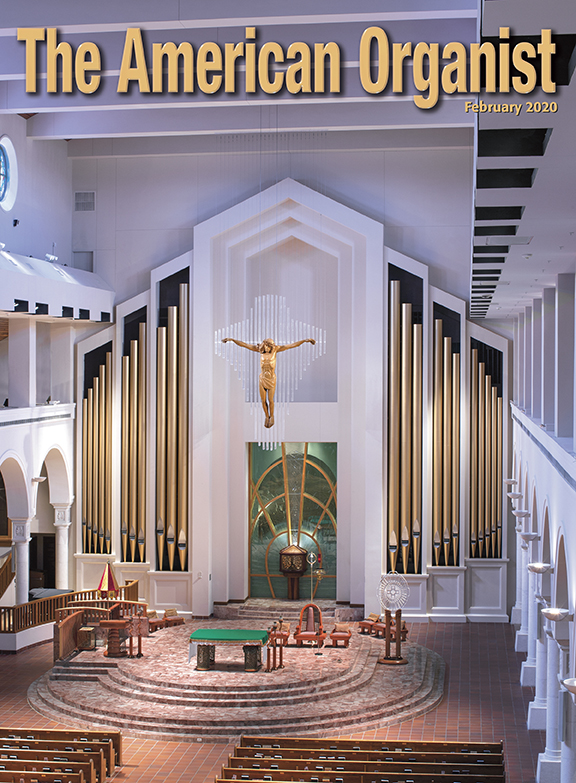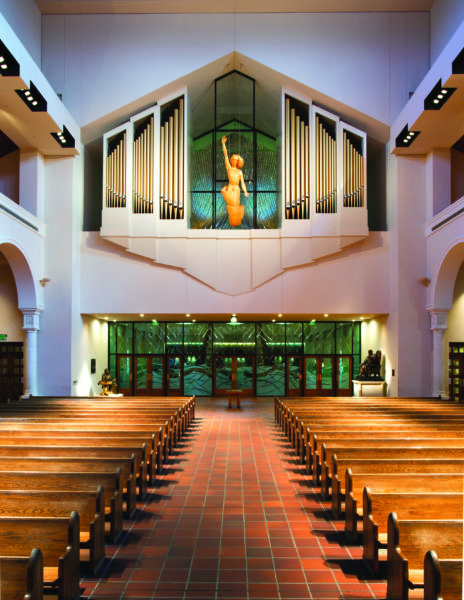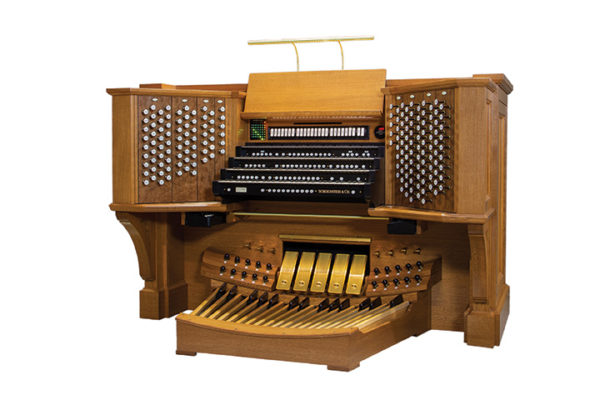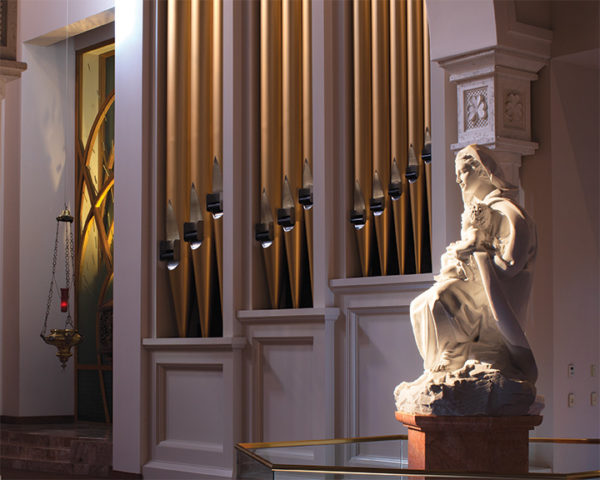Wesley United Methodist Church
Muscatine, Iowa
C.B. Fisk Inc.
Opus 153
Stop List
By David C. Pike
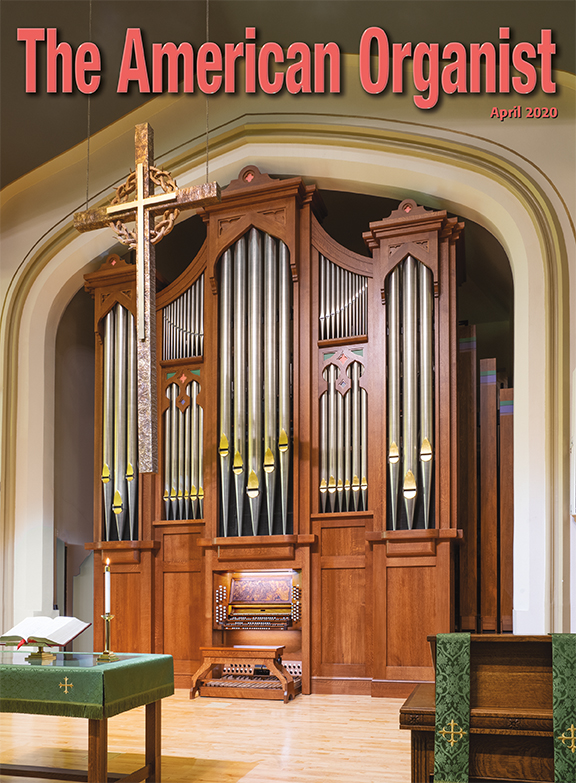
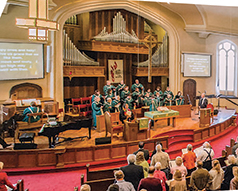
In January 2018, C.B. Fisk was, for the first time in its 57-year history, commissioned to replace a church organ that had been destroyed by an act of God. On March 6, 2017, a tornado swept through downtown Muscatine, Iowa, a small industrial city on the banks of the Mississippi River. During its brief, circuitous path through town, the tornado’s 115-mile-per-hour winds toppled the tall masonry chimney of Wesley United Methodist Church. The chimney’s stone-work came crashing down onto the roof over the pipe organ chamber. The roof collapsed, and in the blink of an eye Wesley’s 1983 four-manual 94-rank pipe organ, the largest in the state of Iowa, had become a heap of twisted, shattered pipes and woodwork. Except for minor damage to one of the sanctuary’s splendid stained glass windows, virtually nothing else in the church building was touched.
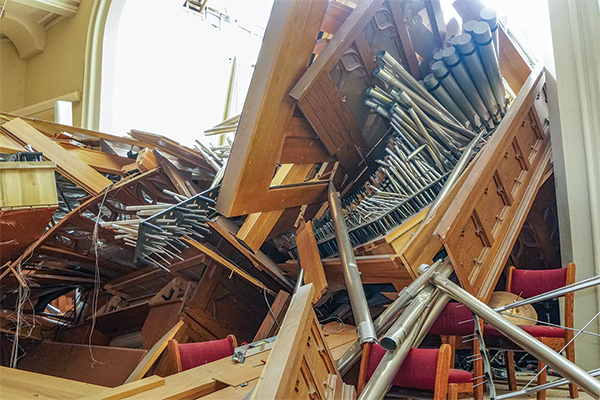
As the rebuilding process began, Sally Potter, organist at Wesley, contacted us to determine our interest in submitting a proposal to replace the ruined organ. It was clear that the organ committee was going about their business with care and thoroughness; they had by then done extensive research into potential builders. Following visits to our Chicago instrument (Opus 123) and to those in Bloomington and Evansville, Indiana (Opuses 135, 91, and 98), the committee decided that Fisk should be their organbuilder. In dialogue with Sally, specifications for a three-manual instrument with attached console and two divisions under expression were developed, and a contract was signed with the church in January 2018. Sally’s directives with regard to Opus 153’s tonal design included “efficient,” “lean and mean,” “colorful,” “some Sturm und Drang,” and “attentive to recitalists.” As part of the Jackson Concert Series, organ recitals, free to the community, have been a part of Wesley’s outreach since 1981. Sally insisted that the new instrument be a “destination” that would attract the profession’s most distinguished organists from around the world. Moreover, Muscatine is less than an hour by car from the University of Iowa, where Gregory Hand presides over a fine organ department.
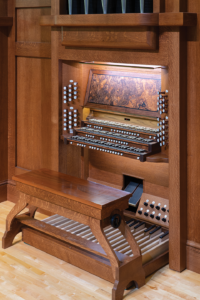
The Fisk process is one of collaboration. To accomplish the visual design, for example, we build a physical 1:16-scale model of the church interior, and the organ case is designed in three dimensions within this model. This approach affords church people the opportunity to participate in the design process, either in person at our workshop in Massachusetts or via shared photos and video. Alongside our visual designer Charles Nazarian, the clients enjoy in-depth involvement in the creation of a suitable and distinguished case design. Sally Potter and the Wesley team were wonderfully conscientious and communicative throughout design development, and, on account of the collaborative process, they can claim a certain ownership in the final case appearance. A distinctive design attribute worth mentioning is the use of local Muscatine mother-of-pearl for stopknob faces and toe-stud labels.
Opus 153 is home to 39 stops, 34 of which are independent voices and 9 of which are reeds. The two expressive divisions, Choir and Swell, are placed side by side at impost level and are oriented back to front. The Great windchests are located above the two expression boxes, immediately behind the upper facade, while the Pedal chests are to either side, outboard of the two boxes. There are numerous plusses to this arrangement, which we had used once previously in our Opus 112 at St. James’s Episcopal Church, Richmond, Virginia. Placing the Choir and Swell divisions low and in close proximity to the choir singers is advantageous for both ensemble and intonation. Keeping the Great pipework up high allows its organo pleno to sing out naturally, well above the singers’ ears, and at the same time enables it to best support congregational song, in large part due to early acoustical reflections from the ceiling close overhead. Significantly, we were able to salvage, rebuild, and revoice three partial ranks of wood pipes from the heap of rubble that was the former organ: the Choir Gedackt 8′ (CC–a#1), the Choir Flûte conique 4′ (CC–g#0), and the Swell Quintaton 16′ (CC–AA#). Thus, a fitting and much-appreciated material and tonal connection to the ill-fated 1983 instrument was realized.
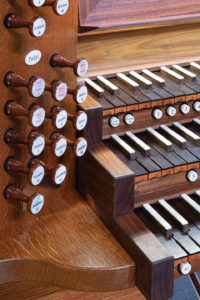
The organ’s tonal profile follows the Fisk practice where every stop counts. Nearly all stops are modeled after or derived from historical European antecedents, and each has something important to say. No stop is a mere placeholder. Equally compelling is the way in which all stops are compatible with one another. Not only does the player have available authentic sounds for the performance of a diverse literature, but there also exist boundless possibilities for smooth orchestral-style crescendos and diminuendos. This is made possible by the inclusion of a state-of-the-art solid-state combination action (for rapid stop changes) as well as through judicious use of the expression boxes. The accompanimental functions that a church organ must serve are thus also well addressed—from supporting a child’s solo voice to leading the most boisterous of hymns or anthems.
The tonal variety of Opus 153 is ably demonstrated by the two complete principal choruses (one 16′-based, the other 8′-based), four different ranks of strings (including the Swell 16′ Quintaton), five 8′ flutes and three 4′ flutes of widely varied construction and timbre, and eight reed voices of diverse provenance. The historical models are mostly German Baroque (Arp Schnitger and his school) and French Romantic (Aristide Cavaillé-Coll), but with some German Romantic influence (a string stop after Friedrich Ladegast). Whether playing pp, ff, or anywhere in between, this organ exhibits an alluring warmth and depth of tone, excellent expressive capabilities, sonic balance, versatility, and poise. It is musically satisfying in all respects and gratifyingly sensitive and responsive to the touch. Fine, enveloping organ tone is the result of using sufficiently large scaling, employing quality materials, working with carefully designed and well-built pipework, and allowing these pipes to speak naturally on relatively gentle wind pressure. A superior tracker key action, achieved through sound mechanical design, attentiveness to detail, and precise adjustment, allows the player to employ a variety of touches and achieve the desired multiplicity of articulations.
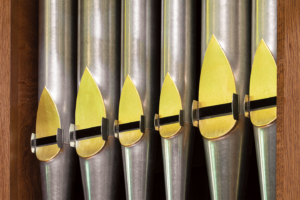
The music program at Wesley is a joint effort, with the choir conducted by music director Ric Smith, and Sally presiding at the organ. Installation took place in April and May of 2019, and finish voicing ensued throughout the summer and into the fall. The inaugural festivities occurred on Sunday, November 24, 2019, beginning with a morning Service of Dedication and continuing with a rousing, expertly played recital by Nathan Laube, professor of organ at the Eastman School of Music. To a full house, Mr. Laube performed a far-reaching and meaty program of works by Charles-Marie Widor, Felix Mendelssohn-Bartholdy, J.S. Bach, Nicolaus Bruhns, Jean Jules Aimable Roger-Ducasse, Jehan Alain, and Maurice Duruflé. As an encore, the audience was treated to the flamboyant Corrente Italiana of Juan Cabanilles.
Here in Iowa—in the city revered as the “Pearl Button Capital of the World”—mindful, purposeful, and tasteful eclecticism has produced a tracker pipe organ capable of convincingly playing almost any literature from any period. The commissioning of Opus 153 represents a resurrection of sorts for Wesley United Methodist Church. We, the artisans of C.B. Fisk, are delighted to have had the opportunity to build this marvelous instrument, and we hope that it will serve and enhance the musical culture of Wesley and the town of Muscatine for centuries to come.
David C. Pike is executive vice president and tonal director of C.B. Fisk Inc. Website:
From the Organist
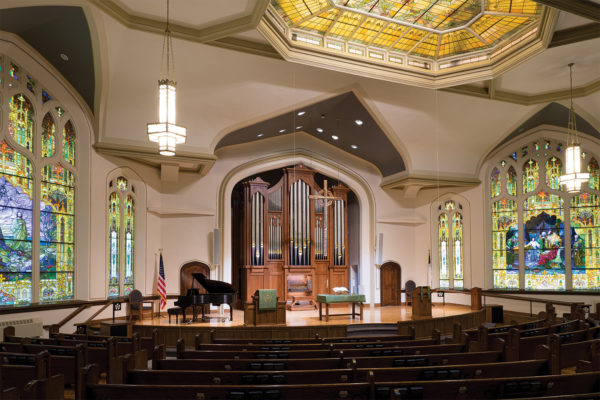
The space at the front of our sanctuary had held the E.M. Skinner organ since 1912, when the church was built. The impressive Casavant Opus 3564 replaced it in 1983. Then a tornado changed the view. When suddenly faced with a gaping hole where those instruments had been, the people of Wesley knew what to do. In true Methodist fashion a committee was formed, study material on organ design was passed out, and work was begun to assure that following generations would continue to be served by an organ of superior quality.
Gregory Hand agreed to serve as consultant. His guidance was invaluable as we defined our needs, visited instruments locally and in St. Louis and the Chicago area, and developed the request for proposals. In the committee’s discussions we described “warm and inviting” tones with the primary purpose of encouraging congregational singing. When Richard Hoskins shared his fondness for Fisk Opus 123 at St. Chrysostom’s Episcopal Church in Chicago, we felt that we had found that sound. We confirmed our suspicions with a trip to both Indiana University and First Presbyterian Church, Evansville, Indiana, where Robert Nicholls shared his continued joy in Opus 98. Before such a momentous commitment, however, we still needed to be assured that there wasn’t someone to be found who had a negative experience with those Fisk people and their instruments. I contacted all of the churches with organs of a comparable size and received 100 percent positive responses from people who are inordinately
fond of their pipe organs.
When we signed the contract with C.B. Fisk, we became part of the Fisk family. There were visits of Fisk members to Muscatine and of the committee to the workshop in Gloucester. There were many emails, telephone discussions, and exchanges of photos. Throughout the design process the people of Fisk listened to our needs and desires as carefully as they later listened to the sounds of pipes in our acoustic through months of voicing. Twelve-hour days of uncompromising work (I mean it—don’t use the word compromise around a Fiskie) for six short months resulted in the large piece of functional art holding that space at the front of the sanctuary. The names of the people of Fisk who contributed to this project are on a plaque inside the case. They are special to us.
That collaborative effort resulted in a congregation and community with ownership and pride in the instrument that many now know as “Gracie Pearl.” (See her Facebook page.) Many people, a broad representation of our congregation and community, carried her in on unloading day with the leadership of Scout Troop 127. Terry Eagle of the National Pearl Button Museum in Muscatine provided the materials that became stopknob faces and toe-stud labels. What was once a mussel in the bottom of the Mississippi is now adding a unique beauty to the stunning woodwork of the case.
Standing behind the Cross with Crown of Thorns is a statement of Grace offered freely to all without judgement of worthiness or righteousness. Her responsive touch makes musician and machine extensions of each other as her music ministers to both the listener and the performer. She offers a Bach fugue to bring order to a chaotic world, a plaintive melody by the oboe or clarinet crying tears of pain or love too deep to express with words, flues to dance life into a weary world, majestic reeds to declare victory of love over power and community over division. She can encourage a divided people to sing with one voice, and we pray that she will for many generations.
Sally Potter
Wesley United Methodist Church

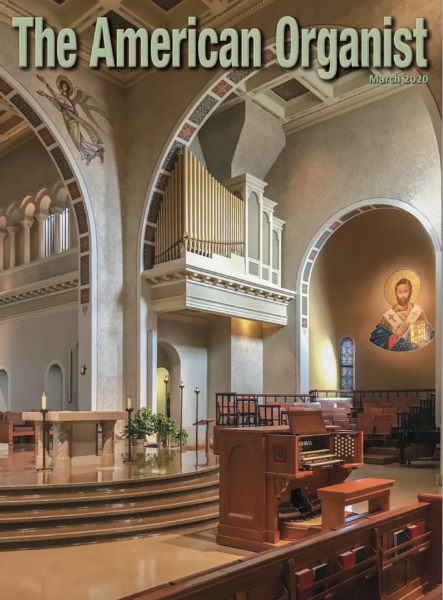
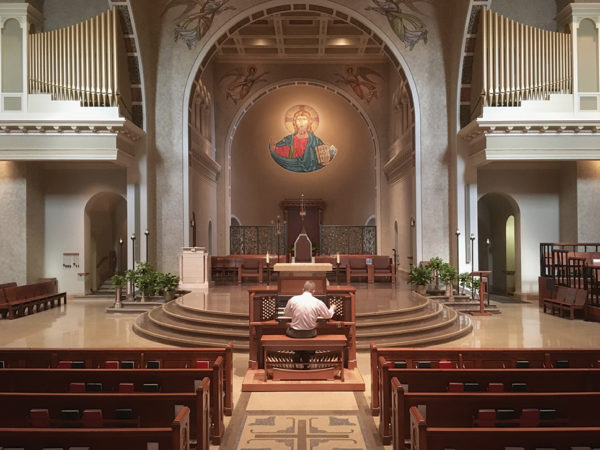
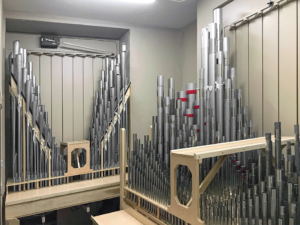
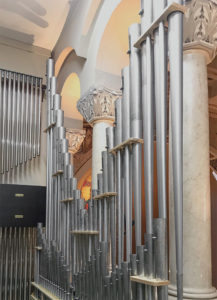
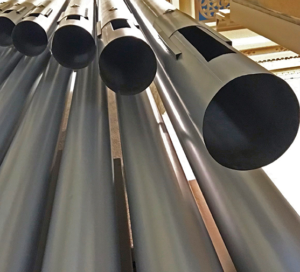 The area’s organists and academics have taken note of this instrument in part because it offers a new perspective on the performance of the post-Mendelssohnian organ repertoire without rejecting any of the structure of the golden age of the instrument. In a region that until recently has favored the interpretive neoclassicism of the last century, organ students are welcomed to a new pipe organ of a more inclusive academic style.
The area’s organists and academics have taken note of this instrument in part because it offers a new perspective on the performance of the post-Mendelssohnian organ repertoire without rejecting any of the structure of the golden age of the instrument. In a region that until recently has favored the interpretive neoclassicism of the last century, organ students are welcomed to a new pipe organ of a more inclusive academic style.